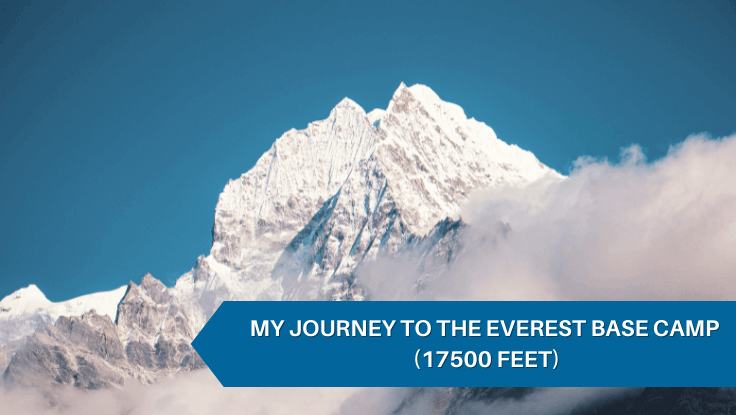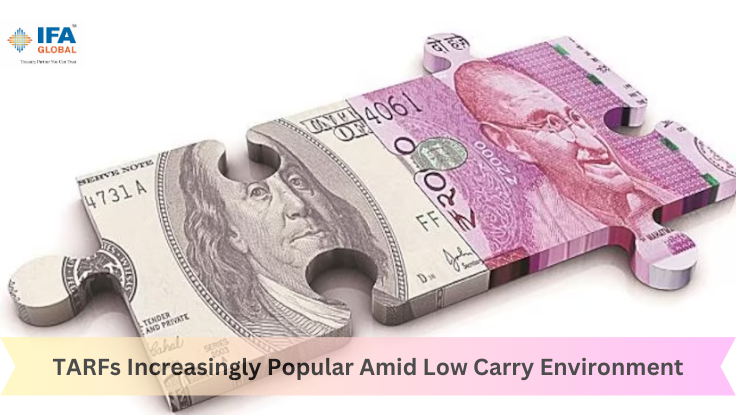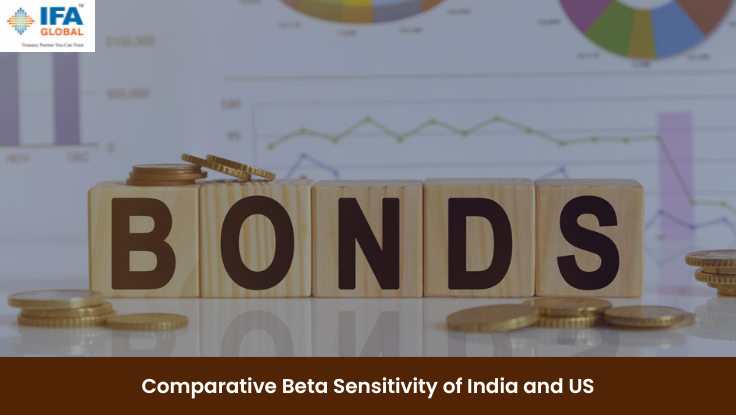My Journey to The Everest Base Camp (17500 feet)
29 June 2017 | By IFA Global | Category - CEO

29 June, 2017
Last year it was the long Vipassana course at Dharamshala that really helped me connect with my inner self and this year on my bucket list was of course the mighty Everest Base Camp (EBC) and Kala Pather Trek. Never having tested myself to extreme physical limits, initially it was a lot of self-doubt but after researching a lot I found out that it was quite doable. Just the right training hours needed to be put in with utmost discipline and perseverance. It was extremely upsetting to know the plight of most people around, who, live a life of mediocrity and expect you to follow the same. One of my friends actually asked me "Why are you doing EBC bhai?" "What is the problem in life? – Life is good"
What inspired me?

Be it personal life or professional life, I feel it is important to challenge the status quo even when the going is smooth. I believe pushing one's boundaries and overcoming one's limitations is the key to blossoming as an individual. It is only when one gets out of one's comfort zone that one can explore new possibilities, think new thoughts, develop new skills and connect with the universe.
I was having a discussion with Rashesh of Edelweiss in one of our Treasury Elite meets a few days back and he inspired me literally – I thought that if a man at 52 can do multiple triathlons then me just at 36 could definitely complete a trek uphill 5300 meters. I discussed my intentions with him and he said "Abhishek it's tough". It acted as a further motivation for me to go for it.
I discussed this with my friend and client Rishit Dalal (Jaycee Industries), 30 years of age who immediately committed himself to tag along.
At least I had a partner whose reasons were 100 percent similar as mine to do EBC. After few months of training my wife Nitika also tagged along making the three of us a complete team pushing each other for the milestone.
During this period, Rishit completed a 3500 meters trek in Africa giving us all a push once again.
Are you mentally and physically prepared?
I started doing some serious research about the trek, browsing literature available online, going through experiences of non-hikers who had made it, watching videos of professional hikers etc. I soon realized it would require a herculean effort. It would require me to completely alter my routine for the next 6-7 months. I realized I would have to change my fitness regime, diet and sleep pattern. I told my gym instructor Rajesh (who unfortunately expired during this period) I was planning to go for the trek and he outlined a grueling training regime for my wife and me, specifically intended at improving stamina and endurance. Sanjay replaced him as our instructor. He supervised us and helped us execute the routine. It involved climbing 25-30 floors 2 times a week to start with and gradually increasing it to 120 floors with a bag pack of 8 -10 kgs with heavy trekking shoes on. (If you have not done it before, trust me, your walk after climbing those many floors makes you look silly). Additionally 3-4 early morning gym sessions included extensive workouts comprising cardio cross trainers and circuits. Early mornings my wife and I used to climb up Mount Mary hill in Bandra with backpacks filled with rice as payload. (I never knew Mount Mary hill was that steep while driving all these years!). That's the best preparation I felt we could do living in a city like Mumbai. It is difficult to go for frequent hikes to the outskirts of the city as you have regular business commitments and 2 small girls (Age one and five) to take care of. Though we still managed to do few treks near Matheran (Pep) near Mumbai I personally found them to be quite risky and would strongly advise against it.
As far as diet was concerned, we stuck to a predominantly carb, protein, mineral and fiber rich intake. We started having raw garlic with honey as it helps in thinning your blood and reducing pressure, which is vital at high altitudes. In addition to that our trainer prescribed us other supplements and multivitamins.
Besides the physical preparation there was also a lot of mental conditioning involved. Regular Pranayam (breathing exercise) and Yoga helped build up lung capacity, which is again crucial at high altitudes due to thin air and lack of oxygen. My earlier experience at Vipassana came in handy as well. During the course of grueling physical preparation, there comes a point when you question yourself if the preparation would be good enough for the final trek. You keep asking a lot of people and soon get mixed reactions. Milind from Countryside (a leading travel company in Mumbai) really encouraged and educated me despite the fact that we were going with an international firm.
Never shopped so much!

Shopping for the gear was the most exciting part. We made our purchase of hiking boots (Meidi and Solomon) from London and invested one complete day there with kids. We had been strongly advised to break our shoes at least 6 months before the trek, as inappropriate selection is known to cause painful blisters. (It was a quite a task to explain to my fellow gym buddies as to why I was wearing those shoes, One person actually told me why don’t you buy some decent sports shoes to wear to the gym!!) As the day of the trek approached, we had to ensure that our hiking gear was in readiness. It is imperative to have the right gear and equipment. I shopped the Garmin Fenix 3 HR smartwatch (which was quite useful during the trek). Having the right pair of sunglasses (to shield against snow blindness) and down jackets from North Face or similar (to protect yourself from the freezing temperatures) are equally critical. Crucial inner wears from Columbia with Omni heat technology was a life saver during nights. One has got to decide what one needs to carry and what not to. Your backpack should contain all items that are required to sustain you up at the top but should not be bulky at the same time. Hydrating bags, nourishment (dark chocolates, nuts etc) medication and first aid kit, spare set of sunglasses (I broke my Mau jim the second day and immediately replaced with a Julbo which was available in Namche Bazar fortunately) are a must. Importance of having a good guide and a company cannot be overstated. In short, shopping was a task and an awesome experience – more than anything else we learned so much on mountaineering and hiking gears. We had more than 150 items in the final list and some of them were extremely important due to extreme cold during nights.
The Journey Started on 18th April 2017.

After all the preparation, the day finally arrived. We flew from Mumbai to Kolkata and dropped our kids there. They were so very happy to know that they could enjoy watching TV which they rarely get to see in Mumbai with us. We flew from Kolkata to Kathmandu.
Did some final shopping and took a short haul flight in a 19 seater to Lukla.
On that flight you see mixed reactions of the passengers (coming to terms with the shaky flight) and beautiful landscapes around. You get an initial sense of what lies ahead. Situated at a height of 2860m above sea level, and with an extremely short runway,
Lukla is one of the most dangerous airstrips to land on for a pilot. The pilot has to approach at high air speed to maintain lift while landing (due to thin air) and upon touchdown brake in the nick of time to avoid overshooting the short runway (Any mistake and you are headed straight for the valley ahead!). We started immediately from Lukla to Phakding, our first stop with our guide and porters.
It was a 9 day journey to EBC situated at a height of around 5300m above sea level. To put it into perspective, EBC is around 3800m lower that the summit of Mt Everest and taller than the tallest peaks in the Alps.

We started from Lukla and our trail was supposed to take us through Phakding, Namche Bazaar, Tengboche, Dingboche, Lobuche and finally EBC. The treks became longer starting with 5 hours initially and going up to 10-12 hours on some days. We made it a point to start early on daybreak. The trek progressively becomes more challenging, as air becomes thin, oxygen level drops and temperatures plummet. Nights especially are biting cold. It is common for fatigue and breathlessness to set in. But you overcome it as you feel it is a minor trade off for the captivating views of some of the tallest peaks in the world. It is important to keep the morale of the group high by egging each other on. The sheer energy of a 5 year old in another group and the grit and resolve of an elderly couple probably in their late 60s or early 70s rubbed off on me. At Namche Bazaar we got the first glimpse of the bigger mountains like AmaDablam (6100 mtrs), Lhotse (4th largest in the world), and the Mt Everest. It was an enriching experience, taking us closer to nature every single day.
The Unforeseen Challenge:
We were not on Diamox (a preventive medicine for altitude sickness) and were quite fine without it. We were advised against it by our guides which I think was a mistake. Unfortunately, while at Dingboche (just a day before the summit) my wife suffered acute breathlessness and was not in a position to continue the trek. In the interest of safety we decided it was best to cut short the trek and send her back to Lukla the next day. To our surprise and extreme shock her oxygen level dropped from 65 to 38 (normal is 85-90). In the middle of the night, with limited Oxygen cylinders available and no medical service, the only option was to come down through a pony in such extreme freezing temperatures or take a chartered helicopter back to Kathmandu.

We decided to go back together early morning next day through a chopper arranged by our insurance company. (Weather supported us since after we took off no chopper flew for the next 48 hours and pony escort down was the only savior to fight altitude sickness). We had to convince our insurance company through multiple satellites calls that it was a genuine case, thanks to an extremely negative branding of Nepal Tour operators. It was an extremely difficult and testing moment for us, at one point we were just one day shy from reaching our goal of hiking till EBC that we had planned for over the last 6-8 months and on the other hand it was a matter of safety of my wife. We decided that her safety was of paramount importance and therefore we decided to abort the trip at that stage. It was a difficult choice to make, having reached that close, but considering the situation, a prudent one.
The hidden takeaway and opportunity
On the flight back home I reminisced the entire journey from planning and preparation to the actual trek. I felt a deep sense of satisfaction on being able to overcome all my shortcomings and make it that far. I realized it was more the journey than the destination that mattered as the experience had indeed transformed me. The days just flew while on the actual trek. Rather than the actual trek, it was the hours of grueling mental and physical preparation that went in earlier that helped me push my limits.
After I shared my experience of the trek with my friends and family, they were fascinated. (Many of them had earlier advised me against going for it). A few of them are even considering going for it now and have requested me to share detailed information. I believe it’s just the decision to step out of your comfort zone that is the most difficult to make. After that things become easy as you persevere.
In the midst of the mountains you realize the triviality of your existence and how vulnerable you are to the vagaries of nature. Not being able to make it to the final destination EBC and Kalapatthar did play on my mind for sometime and still haunts me sometimes. Maybe destiny wants me to set a bigger, tougher and an even more challenging goal next time around and hence caused the final destination to elude me. I am now waiting eagerly for the next 2 big expeditions – Kilimanjaro (5895 meters – highest mountain in Africa) and the technical Island Peak in Nepal (A climbing expedition to 6189 meters) in 2018.




